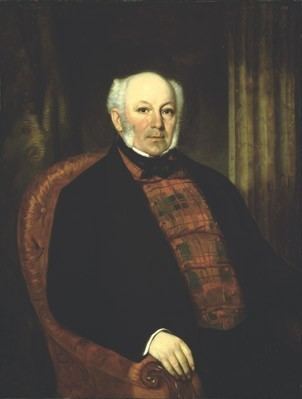Name Allan MacNab | ||
 | ||
Profession businessman, soldier, lawyer Similar People | ||
Sir Allan Napier MacNab, 1st Baronet (19 February 1798 – 8 August 1862) was a Canadian political leader and Premier of the Province of Canada, from 1854 to 1856.
Contents
- Sir allan macnab pool renovation hamilton ontario canada
- Early life
- Political career
- Death
- Family
- Legacy
- References
Sir allan macnab pool renovation hamilton ontario canada
Early life
He was born in Newark, (now Niagara-on-the-Lake) to Allan MacNab and Anne Napier; daughter of Captain Peter William Napier, R.N., the commissioner of the port and harbour of Quebec. When MacNab was a one-year-old, he was baptized in the Anglican church in St. Mark's Parish of Newark. His father was a lieutenant in the 71st Regiment and the Queen's Rangers under Lt-Col. John Graves Simcoe. After the Queen's Rangers were disbanded, the family moved around the country in search of work and eventually settled in York (now Toronto), where MacNab was educated at the Home District Grammar School.
As a fourteen-year-old boy, he fought in the War of 1812. He probably served at the Battle of York and certainly as the point man in the Canadian forlorn hope that headed the Anglo-Canadian assault on Fort Niagara. The 20 local men eliminated two American pickets of 20 men each with the bayonet before taking part in the final assault. Captain Kerby, of the Incorporated Militia Battalion, was reportedly the first man into the fort.
After the war, he studied law in Toronto and was admitted to the bar in 1824. In 1826, MacNab moved from York to Hamilton, where he established a successful law office, but it was chiefly by land speculation that he made his fortune. There was no Anglican church in Hamilton yet so MacNab attended a Presbyterian church until Christ Church was established, in 1835.
Political career
In 1830, he was elected to represent the city in the Legislative Assembly of Upper Canada, a position that he held for some 27 years.
As a member of the legislature, MacNab opposed the reform movement in Upper Canada that was led by William Lyon Mackenzie. When Mackenzie led the Upper Canada Rebellion in 1837, MacNab was part of the British militia that moved against Mackenzie at Montgomery's Tavern in Toronto on 7 December, dispersing Mackenzie's rebels in less than an hour. On 29 December, MacNab and Captain Andrew Drew, of the Royal Navy, commanding a party of militia, acting on information and guidance from Alexander McLeod, attacked Mackenzie's supply ship at Navy Island. The sinking of the SS Caroline became known as the Caroline affair.
MacNab then led a militia of his own against the rebels marching towards Toronto from London, led by Charles Duncombe. Duncombe's men also dispersed when they learned that MacNab was waiting for them. In 1838, he was knighted for his zeal in suppressing the rebellion. He served in the Legislative Assembly of the Province of Canada, leading the province from 1854 to 1856. He was elected to the Legislative Council of the Province of Canada in 1860, representing Western Division until his death. When Parliament met at Montreal, MacNab took apartments there at Donegana's Hotel.
A successful entrepreneur as well as politician, MacNab, with Glasgow merchant Peter Buchanan, was responsible for the construction of the Great Western Railway (Ontario).
MacNab was married twice. His first wife was Elizabeth Brooke, who died 5 November 1826, possibly of complications following childbirth. Together, they had two children. His second wife was Mary Stuart, who died 8 May 1846 and was a Catholic. The couple's two daughters, Sophia Mary and Minnie, were raised as Catholics.
Death
MacNab died at his home, Dundurn Castle, in Hamilton. His deathbed conversion to Catholicism caused a furor in the press in the following days. The Toronto Globeand the Hamilton Spectator expressed strong doubts about the conversion, and the Anglican rector of Christ Church declared that MacNab died a Protestant.
However, MacNab's Catholic baptism is recorded at St. Mary's Cathedral in Hamilton, at the hands of John Farrell, Bishop of Hamilton, on 7 August 1862.
When the 12th Chief of Clan Macnab died, he bequeathed all his heirlooms to MacNab, whom he considered the next Chief. When the latter's son was killed in a shooting accident in Canada, the Chief of Clan Macnab passed to the Macnabs of Arthurstone.
Family
He married his second wife, Mary, daughter of Mr. Sheriff Stuart, of the Johnstown District, Ontario. The couple's eldest daughter, Sophia, Countess of Albemarle, was born at Hamilton. She married at Dundurn Castle, Hamilton, on 15 November 1855, the Right Honourable William Coutts Keppel, Viscount Bury, afterwards William Keppel, 7th Earl of Albemarle, who died in 1894. Sophia was the mother of Arnold Allan Cecil Keppel, 8th Earl of Albemarle (born in London. England, 1 June 1858) and of eight other children. One of her sons, the Honourable Derek Keppel served an Equerry to The Duke of York after 1893 and was in Canada with His Royal Highness, in 1901 at 53 Lowndes Square, London, S. W., England.
MacNab is a direct ancestor of HRH The Duchess of Cornwall.
Legacy
MacNab Street and Sir Allan MacNab Secondary School in Hamilton, Ontario are both named after him.
Dundurn Castle, his stately Italianate style home in Hamilton, is open to the public.
A ship was named Sir Allan MacNab and was sturdily built in Canada but was not altogether designed for speed. The master in 1855 was Captain Cherry, and the tonnage of the ship was 840, then quite large. The ship was named after the Canadian hero and statesman.[2]
